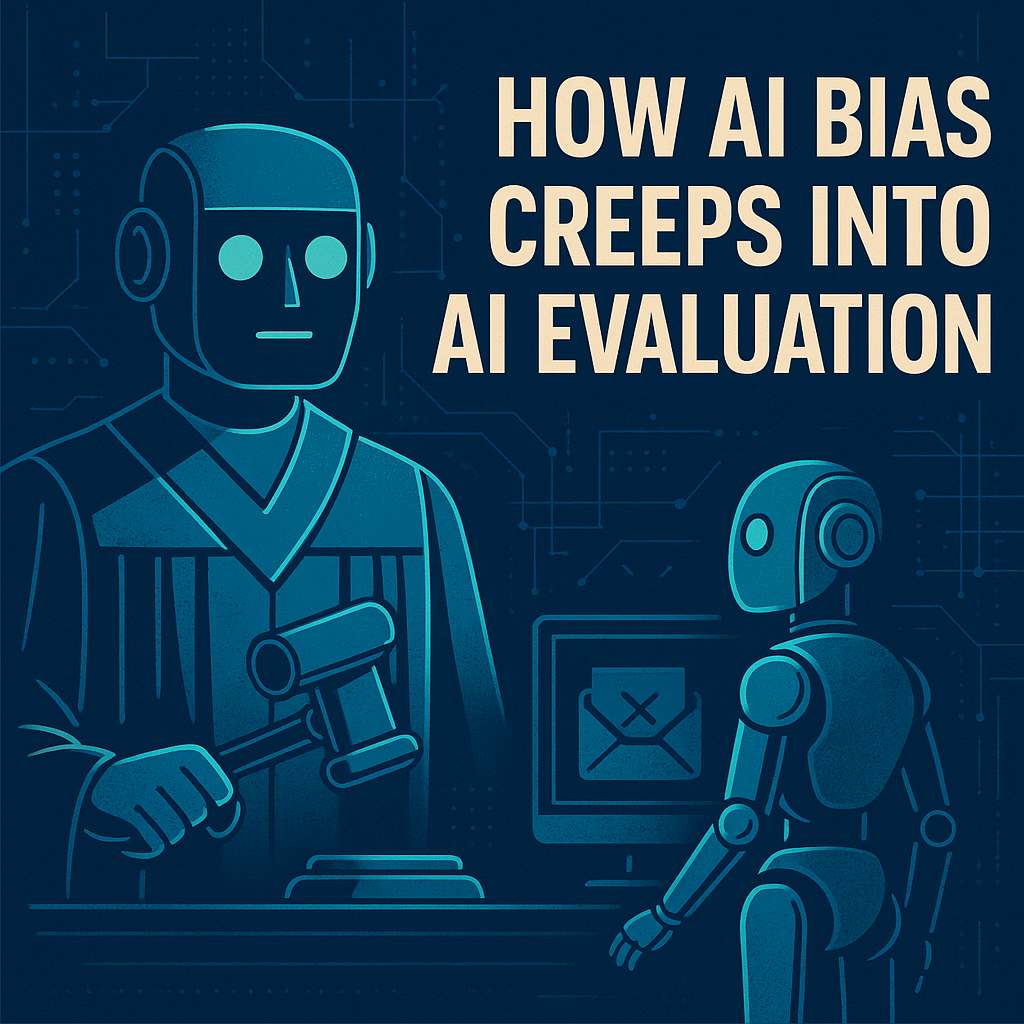The Future of AI Evaluation: Why LLM-as-a-Judge Is Replacing Human Review
When OpenAI released GPT-3, the world marveled at its ability to generate fluent, coherent language. By the time GPT-4 and Claude 3 arrived, the question had changed: not can models generate convincing content—but can we trust what they generate?
For enterprises building with generative AI, that question defines the future of innovation. Whether you’re deploying an AI assistant to summarize legal documents, analyze code, or generate compliance reports, evaluating the accuracy and reliability of model outputs is now a mission-critical step.
At Ragmetrics, we see this reality play out daily. Enterprises are rapidly adopting generative AI, but they’re also realizing a difficult truth: you can’t scale what you can’t measure.
The Challenge of Evaluating Generative AI
In our earlier post, The Urgency of Testing GenAI and LLM Solutions, we highlighted how untested models can introduce regulatory, financial, and reputational risk. The biggest issue isn’t that AI gets things wrong—it’s that it gets them convincingly wrong.
A model might generate an answer that looks perfect at first glance, but a closer read reveals fabricated citations, false logic, or outdated references. This phenomenon—often called plausible hallucination—is what makes evaluation so hard. The text sounds human, yet the facts don’t hold.
Traditional human review, though valuable, breaks down at scale. Even a small enterprise using GenAI for internal automation can generate thousands of model outputs daily. Human reviewers can’t evaluate them all, nor can they apply criteria consistently.
And there’s a deeper problem emerging in research circles: the evaluation generalization issue. As models grow exponentially in scale and capability, benchmark datasets remain static and quickly become obsolete. A 2025 arXiv study noted that model accuracy on classic benchmarks like GSM8K (a math reasoning test) rose from roughly 74% to 95% in under two years, essentially saturating the test and making it ineffective for meaningful differentiation. When your test stops challenging the model, you lose visibility into true performance.
The same study warns that static benchmarks also risk data contamination—where models inadvertently memorize test data from their training sets, inflating performance scores. For enterprise teams depending on these metrics to gauge reliability, that’s a false sense of confidence.
The conclusion is clear: evaluation must evolve as fast as the models themselves.
The Rise of LLM-as-a-Judge
That’s where LLM-as-a-Judge comes in—a concept now moving from academic labs to enterprise production pipelines. In essence, it’s the use of one or more language models to evaluate the output of another.
Instead of manually checking every response, LLM evaluators can assess outputs automatically for factual accuracy, reasoning quality, tone alignment, and safety. This approach scales instantly and—when tuned properly—produces highly correlated results with human judgment.
Researchers at Stanford found that GPT-4’s scoring of model responses matched expert human evaluators more than 80% of the time. Anthropic reported similar findings, with LLM judges outperforming average human raters on certain reasoning tasks.
At Ragmetrics, we’ve embedded these insights directly into our LLM evaluation framework. Our approach blends automated evaluation with human oversight: judge models handle repetitive scoring at scale, while human experts audit edge cases and continuously refine the rubric. The result is an explainable, repeatable, and defensible evaluation loop that aligns with enterprise governance standards.
Why Enterprises Need Automated Evaluation
Every enterprise faces the same paradox: as LLMs get smarter, verifying them gets harder.
Generative models are increasingly multimodal, multilingual, and context-aware. Yet these same qualities make them more unpredictable. An LLM can generate a 10,000-word policy summary that’s linguistically flawless but contains a single factual error—one that could violate compliance or mislead a customer.
In regulated industries, that’s unacceptable. Finance teams must ensure AI summaries of earnings reports meet SEC disclosure standards. Healthcare applications must safeguard clinical accuracy under HIPAA. Legal AI assistants can’t afford to invent citations.
Without scalable evaluation, enterprises can’t deploy these systems responsibly. That’s why the shift from manual QA to automated, AI-driven evaluation is accelerating. Ragmetrics’ customers are embedding our AI evaluation platform directly into their CI/CD workflows, running model checks automatically before deployment. If accuracy drops by even a few percentage points, they know before production—not after customers find out.
Lessons from Research: Toward Dynamic, Multi-Evaluator Systems
The latest research offers two key lessons for anyone evaluating LLMs in production:
- Static benchmarks are dying. As noted in arXiv:2504.18838v1, fixed datasets can’t keep up with rapidly scaling model capabilities. Evaluations must be dynamic, continuously refreshed, and resistant to contamination.
- Evaluation needs diversity. A single judge model introduces bias and blind spots. Using multiple evaluators—general-purpose and domain-specific—provides a more robust signal through inter-model agreement.
Our own architecture mirrors these recommendations. Ragmetrics deploys multi-evaluator ensembles tuned to different domains (e.g., reasoning, factuality, tone). Evaluators compare their assessments, and any discrepancy triggers human review. Over time, this creates a living evaluation system—one that improves with every iteration, not one locked in a static dataset.
This approach doesn’t replace human reviewers; it elevates them. Humans define the scoring policies, design the rubrics, and audit outliers. LLMs do the heavy lifting. The partnership yields both scale and transparency.
Evaluation and Compliance: Building Trust in the Age of Regulation
AI regulation is coming fast, and with it, new expectations for accountability. The EU’s AI Act and the U.S. Executive Order on AI both emphasize measurable standards for accuracy, robustness, and transparency. Organizations must not only evaluate their models but prove they evaluated them correctly.
Compliance auditors now ask whether your test sets are current, contamination-resistant, and representative of real-world data. They want to see documentation: when was the benchmark refreshed? Which evaluator scored the outputs? How did inter-rater agreement look?
Our enterprise clients use Ragmetrics’ LLM evaluation framework to meet these emerging expectations. Every model test produces a structured audit log that records the evaluator, dataset version, and evaluation results. That record becomes a traceable evidence trail—a key requirement for AI governance and legal defensibility.
In practice, that means when your CISO or regulator asks, “How do you know your model is safe?”—you have the data to answer.
From Testing to Continuous Verification
The next evolution of evaluation isn’t a process—it’s a system. Enterprises are moving from periodic model testing to continuous verification: real-time monitoring of AI performance in production.
Imagine an LLM-as-a-Judge continuously sampling responses from your deployed chatbot, comparing them to reference standards, and flagging deviations automatically. That’s what Ragmetrics is building.
By integrating evaluation into the development pipeline, enterprises can benchmark new model versions, detect performance drift, and fine-tune prompts—all without pausing deployment. It’s continuous quality assurance for AI, designed to meet the velocity of modern software development.
Why Trust Must Be Measured
AI progress shows no sign of slowing. Models like GPT-5, Claude 3.5, and Gemini 2 demonstrate leaps in reasoning, creativity, and adaptability. But progress without evaluation is performance without accountability.
As models become more powerful, enterprises must become more disciplined. You wouldn’t deploy a new cybersecurity system without penetration testing or a financial model without audit. Generative AI deserves the same rigor.
That’s the promise of LLM-as-a-Judge. It’s not replacing human review—it’s amplifying it, turning subjective evaluation into a measurable, reproducible science. It ensures every response, from every model, is verified against transparent criteria before it reaches customers.
A Call to Evaluate with Confidence
Generative AI will reshape industries, but only if it’s built on trust. The future of enterprise AI depends on our ability to evaluate, verify, and prove that our models are doing what we claim they do.
Ragmetrics is leading that charge. Our AI evaluation platform and LLM evaluation framework make it possible to assess large language models automatically, continuously, and at scale—so you can innovate confidently.
To dive deeper into implementation best practices, download our Mastering LLM-as-a-Judge guide. It outlines how to design multi-evaluator systems, reduce benchmark contamination, and align AI governance with real-world performance.
The enterprises that will win the GenAI race aren’t those who build the fastest models—but those who build the most verifiable ones. The future of AI belongs to those who can prove their models are right.
More From Blog
Validate LLM Responses and Accelerate Deployment
RagMetrics enables GenAI teams to validate agent responses, detect hallucinations, and speed up deployment through AI-powered QA and human-in-the-loop review.
Get Started









%201.svg)

